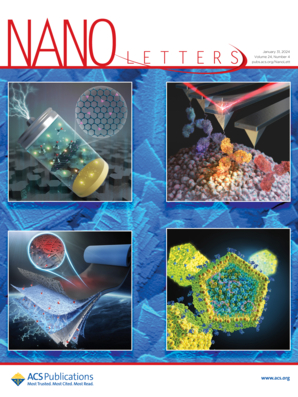Biomass Hydrogel Electrolytes toward Green and Durable Supercapacitors: Enhancing Flame Retardancy, Low-Temperature Self-Healing, Self-Adhesion, and Long-Term Cycling Stability
IF 9.6
1区 材料科学
Q1 CHEMISTRY, MULTIDISCIPLINARY
引用次数: 0
Abstract
Hydrogels have shown promise as quasi-solid-state electrolytes for flexible supercapacitors but face challenges such as poor self-repair, unstable electrode adhesion, limited temperature range, and flammability. Herein, an all-round green hydrogel electrolyte (silk nanofibers (SNFs)/peach gum polysaccharide (PGP)/borax/glycerol (SPBG)-ZnSO4) addresses these issues through dynamic cross-linking of peach gum polysaccharide and silk nanofibers with borax, integrating varieties of key property including high water retention, broad temperature tolerance (−20 to 90 °C), excellent self-adhesion (60.7 kPa for carbon cloth electrodes), satisfactory flame retardancy (limited oxygen index of 51%), low-temperature self-healing (−20 °C), and good ionic conductivity (7.68 mS cm–1). The resulting supercapacitor exhibits excellent cycling stability with 98.2% capacitance retention after 40,000 long cycles at 25 °C. The specific capacitance retention remains above 90% even after 15,000 cycles at high/low temperatures (50 °C/–20 °C). Furthermore, the flexible supercapacitor demonstrates stable performance under mechanical stimuli (180° bending and perforation), highlighting the potential of biomass hydrogels in flexible energy storage devices.

面向绿色耐用超级电容器的生物质水凝胶电解质:增强阻燃性、低温自愈性、自粘性和长期循环稳定性
水凝胶有望成为柔性超级电容器的准固态电解质,但也面临着自我修复能力差、电极附着力不稳定、温度范围有限以及易燃性等挑战。在此,一种全方位的绿色水凝胶电解质(蚕丝纳米纤维(SNFs)/桃胶多糖(PGP)/硼砂/甘油(SPBG)-ZnSO4)通过桃胶多糖和蚕丝纳米纤维与硼砂的动态交联解决了这些问题,集成了多种关键特性,包括高保水、宽温度耐受性(-20 至 90 °C)、优异的自粘性(碳布电极为 60.7 kPa)、令人满意的阻燃性(有限氧指数为 51%)、低温自愈性(-20 °C)和良好的离子导电性(7.68 mS cm-1)。所制成的超级电容器具有出色的循环稳定性,在 25 °C 下经过 40,000 次长循环后,电容保持率为 98.2%。即使在高温/低温(50 °C/-20 °C)条件下循环 15,000 次,比电容保持率仍能保持在 90% 以上。此外,这种柔性超级电容器在机械刺激(180°弯曲和穿孔)下也表现出稳定的性能,凸显了生物质水凝胶在柔性储能设备中的潜力。
本文章由计算机程序翻译,如有差异,请以英文原文为准。
求助全文
约1分钟内获得全文
求助全文
来源期刊

Nano Letters
工程技术-材料科学:综合
CiteScore
16.80
自引率
2.80%
发文量
1182
审稿时长
1.4 months
期刊介绍:
Nano Letters serves as a dynamic platform for promptly disseminating original results in fundamental, applied, and emerging research across all facets of nanoscience and nanotechnology. A pivotal criterion for inclusion within Nano Letters is the convergence of at least two different areas or disciplines, ensuring a rich interdisciplinary scope. The journal is dedicated to fostering exploration in diverse areas, including:
- Experimental and theoretical findings on physical, chemical, and biological phenomena at the nanoscale
- Synthesis, characterization, and processing of organic, inorganic, polymer, and hybrid nanomaterials through physical, chemical, and biological methodologies
- Modeling and simulation of synthetic, assembly, and interaction processes
- Realization of integrated nanostructures and nano-engineered devices exhibiting advanced performance
- Applications of nanoscale materials in living and environmental systems
Nano Letters is committed to advancing and showcasing groundbreaking research that intersects various domains, fostering innovation and collaboration in the ever-evolving field of nanoscience and nanotechnology.
 求助内容:
求助内容: 应助结果提醒方式:
应助结果提醒方式:


